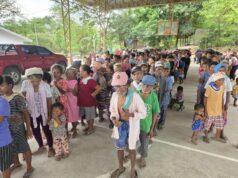CALUMPIT, Bulacan—Anxiety is one word that fills the heart of Ernesto Robles of this town whenever news of flooding reaches him. But he is not anxious of the possible damage that floods may bring to his appliances as he and his family have moved them to a higher part of his house.
His concern are his two daughters who go to school every day and have to wade through the about three kilometer submerged farm-tomarket road before reaching the main road to Calumpit town proper, then to Malolos City.
Robles’ situation is just one of many in this flood-prone town located in a country described by the Citizen’s Disaster Response Center (CDRC) in 2011 as one of the most frequently hit by disasters, and by the United Nations Office for Disaster Risk Reduction (UNODRR) in its 2012 report as one of the top Asian countries worst hit by disasters.
The Climate Change Commission (CCC) and World Bank along with the International Development Research Center (IDRC) said in separate reports earlier this year that the Philippines’ geographical location aggravated by climate change made it one of the hotspots to climate change impacts.
This includes sea level rise, landslides, droughts, and of course, floods. Perennial flooding in Bulacan caused by sea level rise, monsoon rains, dam releases and backflooding from eastern Central Luzon is a major concern for fi shpond operators like Resty Inocencio of the coastal town of Hagonoy.
Manning a one-hectare fishpond inherited from his grandparents at Barangay San Sebastian, Inocencio said that in the last 10 years, his income has constantly gone down because of floods. The same was echoed by the husband and wife team of Narciso and Annie Baesa whose main source of livelihood is to buy seafood in the said town which they sell at the Novaliches market in Quezon City.
They said that prices of fi sh keep going up due to low production, while their buyers are buying less. The above situations mirror separate reports by the CDRC, WB, CCC and the IDRC that disaster impacts in the country not only claim lives, billions of pesos of damages in properties and infrastructures, but also on the economy and livelihood of people.
The more poignant part of the story is the fact that people’s capability to adapt to impacts of climate change aggravated disasters remain low as government and other policy makers seem not to learn lessons from the past.
Engineer Roderick Dela Cruz, a Filipino dam safety expert from California put it bluntly: “Kung baga sa estudyante, may masters na o doctoral degree na dapat ang Bulacan kapag ang pag-uusapan ay pagtugon sa kalamidad tulad ng baha.” Dela Cruz’s statement is now without basis in the last few years and in the past decades.
Last June, the WB report showed that Bulacan is included in the list of 23 provinces in the country considered to be at high risk to disasters most of which are climate and weather hazard related.This was affirmed by two major fl oods to hit Bulacan within 60 days.
First was in August, and the second on October 12 when flashfloods brought by Typhoon Santi ravaged the towns of San Miguel, San Ildefonso, and San Rafael in eastern Bulacan.
Days later, the towns of Hagonoy and Calumpit were inundated by backfloods from the Candaba Swamp draining to Manila Bay. The province has a long history of flood dating back to the late ‘50s but what remain etched in the memory of many Bulakenyos are the series of month long deep floods that hit the province in the ‘70s.
Tomas Martin, a 92-yearold lawyer from Hagonoy and one of the four living former governors of the province said he could still remember the fl oods in 1970, ‘72, ‘74, ’76, and ‘78. Of the five flood events, he said the deepest was in 1972, but the worst was in 1978.
The same is affirmed by incumbent Gov. Wilhelmino Alvarado who described the 1978 flood as partly “manmade.” He said that a an employee of the National Power Corporation (Napocor) which manages the Angat Dam, inadvertently opened the floodgates of the dam too high at the height of Typhoon Kading.
This led to the release of over 5,000 cubic meters per second (cms) of water into the Angat River in the middle of the night killing many and damaging billions of pesos worth of crops and properties.
However, Martin believes that the 2011 flood brought by Typhoons Pedring and Quiel as the deepest to hit the province, even submerging the altar of the National Shrine of St. Anne in Hagonoy town. For many Bulakenyos, the 2011 flood is a searing warning that it could happen again.
This is due to the fact that it occurred at least 30 years since the construction of the Labangan Channel and the Pampanga Delta Development Project Phase-I (PDDP- I).
A man-made channel meant as flood control, Labangan was completed in 1979, while the PDDP-I was completed in 1989. Since the 2011 fl ood, the Provincial Disaster Risk Reduction Management Office (PDRRMO) estimated that damages of fl oods in Bulacan have reached at least P3 billion.
Such did not include lives lost, and increasing impacts to vulnerable sectors that include, women, children and senior citizens; and long term effects in environment, livelihood and health.
Dr. Jocelyn Gomez of the Provincial Public Health Office noted that for every fl ood event that occurred in the province, there was an increase in incidents of water borne disease, including leptospirosis. Looking at the long history of flooding in Bulacan, stir up debate on its causes.
For Board Member Ernesto Sulit, Brother Martin Francisco of the Sagip Sierra Madre Environmental Society (SSMES) and other Bulakenyos, one of the main causes is the increasing deforestation of Sierra Madre in eastern Bulacan.
It was affirmed by the PDRRMO, Dr. Flaviana Hilario of the Philippine Atmospheric Geophysical Astronomical Services Administration (Pagasa), But they also noted the increasing impacts of climate change highlighted by intense and prolong rains.
For local chief executives like Gov. Alvarado and Mayors Christian Natividad of Malolos and Ambrosio Cruz of Guiguinto, flooding is partly caused by silted rivers and creeks. They also noted that the width of waterways in the province has dramatically narrowed in the past decades due to encroachment.
In an earlier interview with Hilton Hernando of the Pampanga River Flood Forecasting and Warning Center (PRFFWC) and Nong Rangasa of the Local Climate Change Adaptationfor Development (LCCAD), they noted the lack of Comprehensive Land Use Plan (CLUP) of cities and municipalities.
Both stressed that unplanned land development can have long term impacts that will contribute to flooding. For Engineer Roderick dela Cruz, such developments can exacerbate vulnerabilities.
To address the situation, Dela Cruz suggested long term planning that includes local legislation. As a dam safety expert, he said that “there is an incontrovertible truth that consequences from disasters were aggravated by inadequate program and planning to reduce risks, loss of lives and damages.”
The same was echoed by Rangasa who once served as executive director of the Climate Change Academy in Legazpi City, Albay. Their suggestions are followed by some organizations in Bulacan and converted into actions.
In Calumpit town, the former mayor ordered climate proofing of schools after the 2011 flood, also with biggest fund allocation for communication system needed during disaster. There is also a steady increase in the forming of news rescue groups in the province.
“Na-realize ng marami na hindi lahat ay dapat iaasa sa gobyerno kaya sila mismo ang nagtayo ng grupo at sumailalim sa mga pagsasanay namin,” said Liz Mungcal, head of the PDRRMO. The same was echoed by 1Lt. Nelson Pangilinan of Voice of the New Generation (VNG) Rescue 184 in Hagonoy town.
Pangilinan said, “kailangang magkaroon tayo lahat ng kasanayan, hindi man tayo makasaklolo, tayo man lang ay huwag ng saklolohan.” For his part, Gov. Alvarado asked the Sangguniang Panlalawigan of Bulacan to pass a resolution for additional funds that will be used in establishing evacuation centers in public schools as part of his climate proofing efforts.
Alvarado is now also overseeing preparation of an Emergency Action Plan (EAP) in the province in coordination with the National Power Corporation (Napocor), National Irrigation Administration (NIA) and the Metropolitan Waterworks and Sewerage System (MWSS).
Part of the EAP preparation is the capability building of disaster personnel as the province tries to improve its early warning system (EWS) highlighted by installation of additional weather forecasting instruments like the automated weather stations (AWS) and automatic rain gauges.
The business community is also taking active participation. SM City malls in Baliwag and Marilao towns have joined forces with Weather Philippines Foundation (WPF) in the installation of AWS. Information from said AWS can be accessed online through www.weather. com.ph .
Given the long history of flood related disasters in Bulacan and the understanding that it is caused by multiple factors that affects its population of at least three million, public and private sector took notice. But their efforts are still to be consolidated in order to complement each other.
This might not be far as officials and experts agreed on the need for concerted efforts towards a holistic approach in addressing disasters and properly provide protection to affected citizens like Robles, Inocencio and the Baesas




